PLAYGROUND PSYCHOTICS: AN AUDIO-DOCUMENTARY
 When Zappa was giving his three concerts at the Fillmore East in June,
he was introduced to John Lennon and Yoko Ono,
who had recently moved from London to New York. It was proposed that Lennon and Ono would do a guest appearance at the end
of the late concert that day. Four pieces were prepared, a regular cover song called "Well" and three improvisations. The
ensuing live jam session is more interesting because of its weirdness than for its musical content.
When Zappa was giving his three concerts at the Fillmore East in June,
he was introduced to John Lennon and Yoko Ono,
who had recently moved from London to New York. It was proposed that Lennon and Ono would do a guest appearance at the end
of the late concert that day. Four pieces were prepared, a regular cover song called "Well" and three improvisations. The
ensuing live jam session is more interesting because of its weirdness than for its musical content.
The jam got released as side 4 of John Lennon's "Some time in New York City", an album you can afford to make when you're already rich and famous, when there's no record
company executive trying to obstruct things because it's less commercial. The same applies to Zappa's "Playground psychotics" from 1992, including a re-edited version of the jam.
To quote from the liner notes: "This album moves beyond mere rock 'n roll into the dangerous realm of social anthropology.
It offers to younger musicians the chance to participate vicariously in the touring world of the early 1970's (way back
when it was still fun to do)". And that is exactly what this double CD does. If you go along with Zappa's intentions
it becomes enjoyable. Nearly half of the material is made up of takes from recorded conversations, while being on the road.
The combination with music from three shows works well for building up a documentary and if things had been filmed as well it would
have been nice to have on DVD.
Scumbag
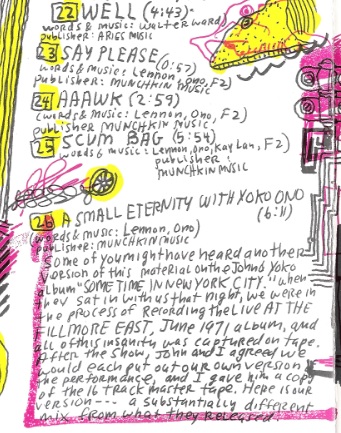 The first improvisation of the jam, named "Jamrag" by Lennon and Ono, consisted of Lennon and Ono stuff and Mothers routines, including Zappa's
"King Kong" theme. The second one, "Scumbag", was another joint jam, this one around a vamp. The four bars vamp was made up of Lennon chanting "scumbag" every two bars
and a bass motif, played with several variations during this song. The vamp tends to dominate, but there's no use
in listening to the "scumbag" line as if it were a lead melody, it simply won't change. The song
gets better listenable when you devote most of your attention to what the other parts are doing. The score below might
help; the "Scumbag" notes are only a minor part of what's going on in total. As composers of "Scumbag" Lennon, Ono, Kaylan and Zappa
get jointly credited. Yoko Ono is singing and squealing through all pieces and gets a
chance to show what sounds her vocal chords can produce in the last improvisation, while Lennon is feedbacking. It's titled "Au" by Lennon
and herself and "A small eternity
with Yoko Ono" by Zappa.
The first improvisation of the jam, named "Jamrag" by Lennon and Ono, consisted of Lennon and Ono stuff and Mothers routines, including Zappa's
"King Kong" theme. The second one, "Scumbag", was another joint jam, this one around a vamp. The four bars vamp was made up of Lennon chanting "scumbag" every two bars
and a bass motif, played with several variations during this song. The vamp tends to dominate, but there's no use
in listening to the "scumbag" line as if it were a lead melody, it simply won't change. The song
gets better listenable when you devote most of your attention to what the other parts are doing. The score below might
help; the "Scumbag" notes are only a minor part of what's going on in total. As composers of "Scumbag" Lennon, Ono, Kaylan and Zappa
get jointly credited. Yoko Ono is singing and squealing through all pieces and gets a
chance to show what sounds her vocal chords can produce in the last improvisation, while Lennon is feedbacking. It's titled "Au" by Lennon
and herself and "A small eternity
with Yoko Ono" by Zappa.
Scumbag, 1:03 till 1:15 (midi file).
Scumbag, 1:03 till 1:15 (transcription).
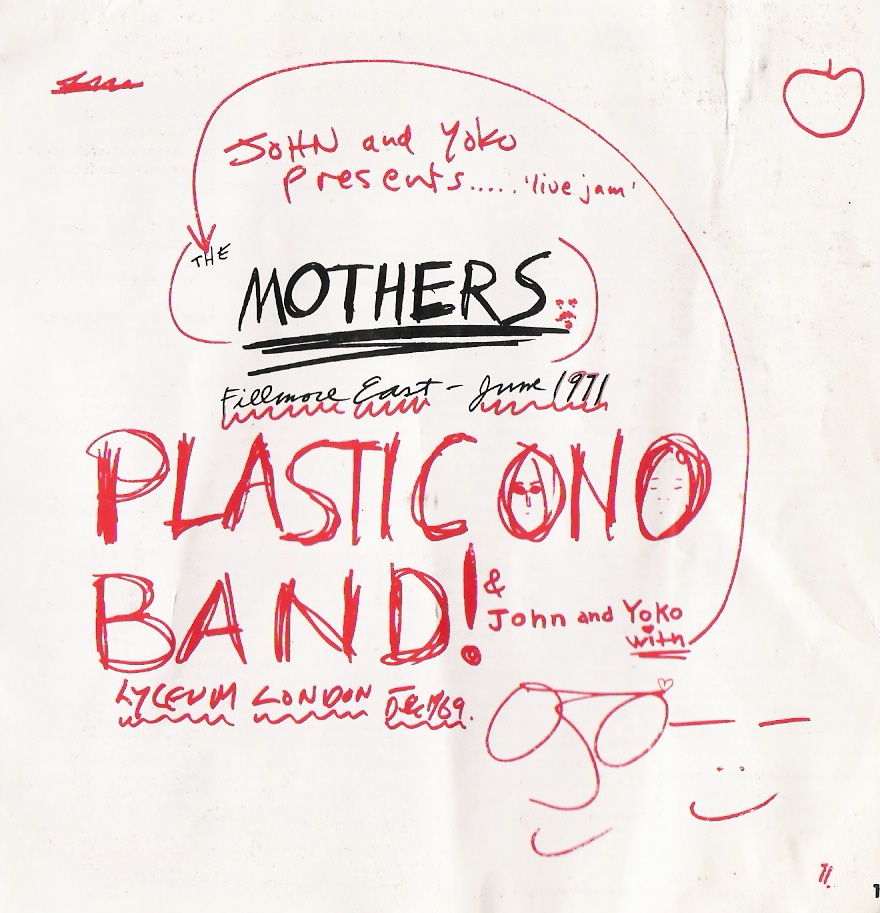 The next day it was agreed upon that both would release a version of their own on their upcoming albums and Zappa gave John
a copy of the tape. Lennon and Ono included this live jam as a bonus on their 1972 double album "Some time in New York City". It's
a political pamphlet with so-called protest songs, half of them by Lennon, half of them by Ono. It sold poorly for Lennon
standards.
Whereas Zappa had parodied
the Sergeant Pepper album sleeve of the Beatles, Lennon now parodied Zappa's Fillmore East cover on his turn, writing all over it in red.
Zappa may have liked this, but he wasn't amused by that he didn't get co-credited for "Jamrag".
On the recent 2005 single CD issue Yoko Ono appears to have skipped most of the jam, the double CD is the original version. For contractual reasons
Zappa couldn't bring out his version that year. It only resurfaced in 1992 on "Playground psychotics". "Jamrag"
got split into "Say please" and "Aaawk", leaving out the "King Kong" theme. The mix of Zappa's "Scumbag" is quite different
from what Lennon's producer Phil Spector did. The guitars aren't in the foreground no more and Howard Kaylan, who was
almost mixed out, is back in business.
The next day it was agreed upon that both would release a version of their own on their upcoming albums and Zappa gave John
a copy of the tape. Lennon and Ono included this live jam as a bonus on their 1972 double album "Some time in New York City". It's
a political pamphlet with so-called protest songs, half of them by Lennon, half of them by Ono. It sold poorly for Lennon
standards.
Whereas Zappa had parodied
the Sergeant Pepper album sleeve of the Beatles, Lennon now parodied Zappa's Fillmore East cover on his turn, writing all over it in red.
Zappa may have liked this, but he wasn't amused by that he didn't get co-credited for "Jamrag".
On the recent 2005 single CD issue Yoko Ono appears to have skipped most of the jam, the double CD is the original version. For contractual reasons
Zappa couldn't bring out his version that year. It only resurfaced in 1992 on "Playground psychotics". "Jamrag"
got split into "Say please" and "Aaawk", leaving out the "King Kong" theme. The mix of Zappa's "Scumbag" is quite different
from what Lennon's producer Phil Spector did. The guitars aren't in the foreground no more and Howard Kaylan, who was
almost mixed out, is back in business.
Say please - Aaawk
"Say please" and "Aaawk" are directed improvisations, credited to Lennon, Ono and FZ. The first little outtake from below is
a sketch of 5 seconds from the beginning of "Say please". The Mothers respond to Zappa's hand signalling with, among others, shouting "ah".
Later on the audience participates. Yoko Ono screams "please" (staff 5). The track ends with another Mothers routine, playing in 5/8.
Say please, 0:05-0:09 (transcription).
Aaawk, 2:12-2:25 (transcription).
"Aaawk" can be subdivided into four little blocks. During the first three blocks you can hear three different bass vamps with the keyboard
players soloing. This title starts as normal diatonic music, but is getting atonal and extravagant towards the end.
During the last block the bass is silencing, while the drummer is beating standard 4/4. It's this block the sample
from above is taken from. It has everybody improvising freely and pretty irregularly (except for the absent bass).
Neither example is suited for being converted into midi format.
Photos/images:
- Yoko Ono, John Lennon and FZ.
- Tracklist of the sequence with comments (Playground psychotics CD, drawn by Cal Schenkel).
- Fillmore East cover by Cal Schenkel with additions in pink by Al Steckler, John and Yoko.
Source: Some time in New York city CD booklet.
Brixton still life
Musically "Playground psychotics" offers less news than the previous live compilations. The unreleased titles are experimental collages while the known pieces
don't differ much from their original releases. Included are two solos, one on keyboard during "Billy
the mountain" and a guitar solo by Zappa called "Brixton still life". It starts over a pedestrian beat on D, the key
thus being D Mixolydian. After 50 seconds the
bass player sets the meter to 4/4. It is from this point onwards that the transcribed section from below is taken.
Brixton still life, 0:50 till 1:20 (midi file).
Brixton still life, 0:50 till 1:20 (transcription).
"Playground psychotics" was constructed in 1992 when Zappa was severely ill. It must have taken quite some time going through the
recorded conversations, but I have the impression that more could have been made of the music if Zappa
would have had more time. I don't know to what
extent the concerts got recorded, but there are some things on the bootlegs from this period, that I personally would have welcomed on this CD. See the previous
section for three examples. There's also a song called "What will this evening bring me this morning" intro to the groupies opera on "Tengo na minchia tanta".
In Zappa's own catalogue this song can only be found on the movie version of "200 Motels" at about 1h:12. It's a variant upon
"What will this morning bring me this evening" with a "go to the club..." section added to it. Years later, in 2021, the ZFT included several takes
of this title in their "200 Motels, 50th anniversary edition" release.
Zanti serenade
"Zanti serenade" is the concert opener of the Rainbow theater show with improvisations on sythesizers. It's attributed to
Underwood, Preston and Zappa. This isn't material to be transcribed and converted into midi format. Zappa describes it as
a sound check in front of the audience, while the members of this audience probably thought it was some sort of avant garde extravaganza.

The fragment above is played between 1:07 and 1:11 on "Playground psychotics". That specific track is an outtake of the actual concert
opener, that can be found in full on the 2022 ZFT release "The Mothers 1971". The pulsing B is the constant factor, other elements can be by approximation.
It's made up of a number of layers:
- Staves 1-3: sort of a crash.
- Staff 4: downwards chromatic line.
- Staff 5: a pulse.
- Staff 6: bass melody.
Note the wide range of the pitches. I've used both the ottava and quindecima sign.
Don't eat there - Super grease
"Don't eat there" is a collage, starting with the Mothers improvising and Zappa playing a figure on guitar, that you might call
the central theme. This figure is a fast chromatic lick, presented in staff 1 from "bar 1" in the fragment below. It gets varied upon two times.
It has no meter and the transcription is by appromation only.
Don't eat there, 0:24-0:29 (midi file).
Don't eat there, 0:24-0:29 (transcription).
This live section gets followed by a transitory vamp in 6/8, that moves over into a field recording with the Mothers ordering
breakfast or lunch in a restaurant. Next they talk about a club they visited the night before with an amateur band playing. At the end the
6/8 vamp returns.

"Super grease" is another improvisation, directed by Zappa. Like the previous song it has eating in restaurants as subject with the Mothers being credited for the words.
This one isn't fit for transcribing either. The snippet above is an approximation of its first three seconds. It features
a sustained downwards moving sung note, an irregular sax melody and a rushing dissonant synthesizer chord/cluster, of which the notes
can't be discerned with certainty.
A typical soundcheck
"A typical soundcheck" is one of the many short excerpts from the road tapes to be found on "Playground psychotics". It sounds as a collage of people talking and a small fragment
with the band jamming, apparently during a soundcheck. The example below features Zappa on guitar and the rhythm section.
A typical soundcheck, 0:37-0:58 (midi file).
A typical soundcheck, 0:37-0:58 (transcription).
To a large degree it's using A minor pentatonic. A B is getting used in bars 6-7, so it can also be interpreted as diatonic with one note being avoided, the F/F#.
This is getting addressed at at the bottom of the Burnt weeny section of this study, the seventh diatonic note paragraph.
Diptheria blues
Diphtheria gets spelled as diptheria on the CD backside, the booklet and the CD itself, so this must have been done deliberately.
It's a field recording, that at the beginning and end gets mingled with the crowd applauding when John Lennon is about to begin singing "Well".
Diptheria blues, 0:00-0:14 (midi file).
Diptheria blues, 0:00-0:14 (transcription).
Zappa writes: "From a Florida dressing room. While Dunbar keeps time on a bottle of Scotch whisky and a wooden table, Howard relates the tale of the San Antonia
diptheria epidemic which we had just escaped". Most of the song depicts the old days in Georgia when poor people were playing blues, with "Asthma Mark" playing a Hohner
harmonica. The 1970 San Antonio epidemic only gets mentioned. The song gets credited to the Mothers of invention. It doesn't say who set this up. When Zappa had no influence upon it,
his contribution may have been limited to recording it.
Concentration moon (1971)
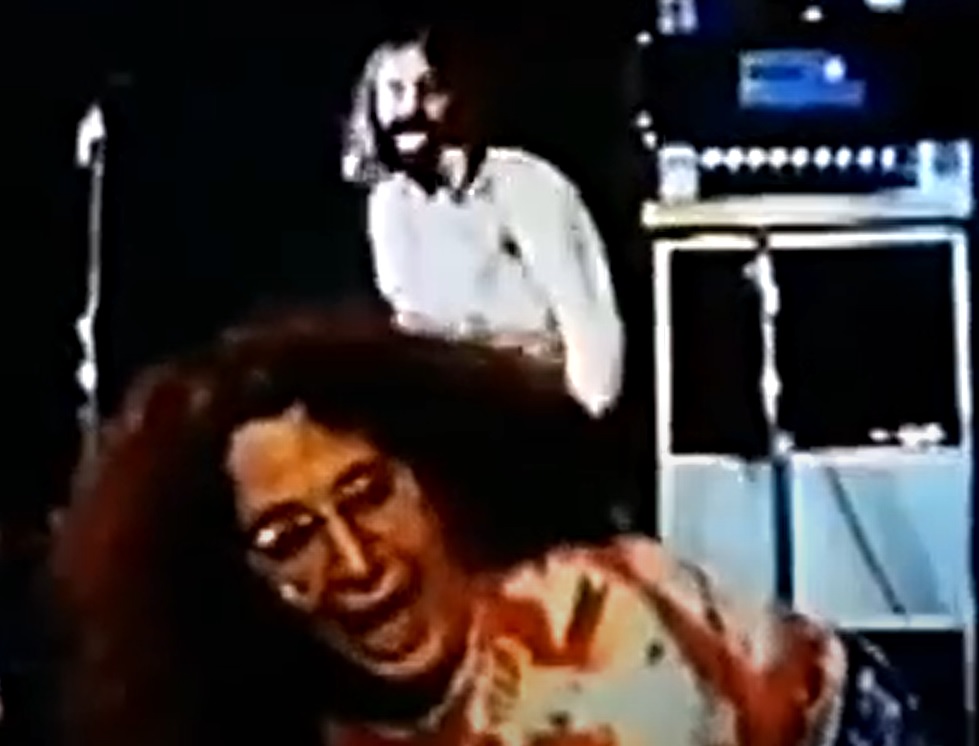 "Concentration moon" on "Playground psychotics" is split into two parts, with the "Sanzini brothers" and one of the road tapes inserted between them.
The "Sanzini brothers" was a parody of circus acts with Ian Underwood performing the music and Mark Volman and Howard Kaylan doing
silly tricks. To the right you can see them while executing the pyramid trick (https://www.youtube.com/watch?v=kUTiZvPYGr8). Others were the sodomy trick and jumping through a hoop trick.
The one on "Playground psychotics" concerned the sodomy trick with Zappa writing in the liner notes: "the audience used to enjoy the Sanzini brothers sodomy trick ... whatever it was.
I can't remember what they were actually doing, except that it sometimes involved an over-sized drum stick".
"Concentration moon" on "Playground psychotics" is split into two parts, with the "Sanzini brothers" and one of the road tapes inserted between them.
The "Sanzini brothers" was a parody of circus acts with Ian Underwood performing the music and Mark Volman and Howard Kaylan doing
silly tricks. To the right you can see them while executing the pyramid trick (https://www.youtube.com/watch?v=kUTiZvPYGr8). Others were the sodomy trick and jumping through a hoop trick.
The one on "Playground psychotics" concerned the sodomy trick with Zappa writing in the liner notes: "the audience used to enjoy the Sanzini brothers sodomy trick ... whatever it was.
I can't remember what they were actually doing, except that it sometimes involved an over-sized drum stick".
Concentration moon, part 2, 1:21-2:03 (midi file).
Concentration moon, part 2, 1:21-2:03 (transcription).
Part 1 goes like "Concentration moon (1968)", the original version on "We're only in it
for the money". See the corresponding section for two examples from this 1968 studio version. Part 2 contains variations upon the ending of this song, bars 4-6
from my second 1968 example. In this case:
- bar 1: playing along the Bbmaj7 chord.
- bar 2: playing along the Dbmaj9 chord. The rhythm of bars 1-2 is the same, with beats 3-4 containing a triplet, followed by two eighth notes.
- bar 3: bars 1-2 get contracted into one bar. Beats 3 and 4 contain a new rhythmic figure.
- bar 4: this bar repeats bar 3, with the detail differences showing the element of improvisation the band could apply.
- bars 5-6: idem with another rhythmic figure for beats 3 and 4.
- bars 7-10: the final "cops kill a freak"/"kill another freak" line. The preceding bars didn't belong to a single scale and this goes even more so for these final bars.
The chords only imply scales, nor can any bass note be seen as a tonic for more than one bar. On Bb the implied scale is Bb Lydian, on Db it's Db major in bar 2
and Db Lydian in bars 3-6.
Mom & dad (1971)
A live version of "Mom & Dad", another song that got released first on "We're only in it for the money".
As it comes to its themes and chords it goes the same as "Mom & dad (1968)", the earlier studio version.
It's also present as a piano arrangement in the FZ Songbook vol. I, of which I'm showing the opening bars in the "We're only in it for the money" section.
Mom & dad, 0:00-0:54 (midi file).
Mom & dad, 0:00-0:54 (transcription).
The difference lies in the handling and voicing of the chords, as well as the tempo, much slower on this occasion. The example above contains:
- Bars 1-4, the instrumental opening of two bars in two shapes. These bars are in E Dorian.
- Bars 5-10, theme 1. Notes start to alter. I've notated these bars in E minor. The chords of bars 5-6 are played in an arpeggio-like manner, going very high. At this point
this makes the live version sound different from the studio version more substantially. The keyboard notes are played with much legato, the bows in my notation are there to simulate
this effect in the midi file.
Bar 6 is played on top of an F natural, briefly suggesting E Phrygian. Bars 7-10 are played largely unisono on "Playground psychotics". Doing that in combination with a simple rhythm and in a slow tempo
is something very rare in Zappa's output. The piano arrangement from the Songbook does have chords during these bars.
- Bars 11-12, the instrumental opening returns.
- Bars 13-14, the beginning of theme 2 in C. Again these bars are largely played unisono, while the Songbook arrangement includes chords.
Sleeping in a jar (1971)
The first two bars in the example below are the last two bars of the written part of this song. See "Sleeping in a jar (1969)"
from the Lost episodes for more about the written theme. This 1971 live version contains two little guitar solo intermezzos by Zappa, 0:25-0:38 and 1:05-1:18.
The second one is included in the example below.
Sleeping in a jar, 1:01-1:29 (midi file).
Sleeping in a jar, 1:01-1:29 (transcription).
Both are in E Dorian. When the second one has ended, it moves over to a chord sequence that serves as a coda for this 1971 version. The bass is moving downwards
chromatically from D to A with the lead keyboard part playing triads on top of it. A second keyboard/guitar part plays a simple melody along with it. Dissonants are avoided,
so in bar 15 the second keyboard part can't continue using an A. The final bar gets cut off (as Zappa often does), lasting about 7/8. It makes the end sound as in D, despite
of the chromatic notes.
Billy the Mountain (keyboard solo)
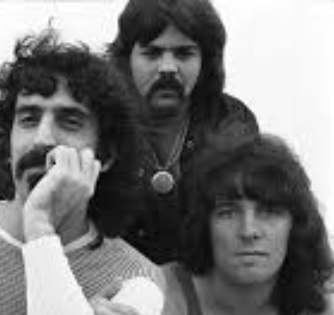 "Billy the Mountain" on "Playground psychotics" comes from the concerts at the Fillmore East, June 1971. All of these concerts is present on
the 2022 ZFT release "The Mothers 1971". The following block concerns the part that got edited out on the first official release of
"Billy the Mountain" on "Just another band from L.A." (see the corresponding section).
"Billy the Mountain" on "Playground psychotics" comes from the concerts at the Fillmore East, June 1971. All of these concerts is present on
the 2022 ZFT release "The Mothers 1971". The following block concerns the part that got edited out on the first official release of
"Billy the Mountain" on "Just another band from L.A." (see the corresponding section).
Billy the Mountain, 22:03-23:09 (midi file).
Billy the Mountain, 22:03-23:09 (transcription).
Bar 1: transitory bar.
Bars 2-5: a figure of one bar that gets played four times. The singers sing after beat during beats 1-3 and on beat during beat 4. The bass can do both, while
the keyboard(s) are playing on beat in a regular manner.
Bars 6-9: these bars with the "Fly to New York" motif can also be heard during other sections of this song.
Bars 10-11: the band moves over from D Mixolydian to a I-II alternation in C Lydian.
Bars 12-27: beginning of the keyboard solo by Bob Harris on a Wurlitzer electronic piano. He starts very calmly, the lead melody containing only a few notes. On a second keyboard
notes are touched upon in the background. The volume may differ per note. I've indicated this a little by using two staffs. Beginning in bar 23, beat 4,
the density increases. Bob Harris only played a few months with the Mothers of Invention. To the right an outtake of a photo by Henry Diltz with him next to
Aynsley Dunbar and Zappa (The Mothers 1971 booklet). He found a namesake in Bob Harris, also playing keyboards with Zappa during the eighties.
Sharleena (1971)
The 1971 live version gets played about twice as fast as the studio version of "Sharleena (1970)"
from the "Chunga's revenge" album. See the corresponding section for its main theme. The example below is part of the end.
Sharleena, 2:05-2:48 (midi file).
Sharleena, 2:05-2:48 (transcription).
Bars 1-7 contain the final theme as you can also hear it on "Chunga's revenge". The differences concern:
- Bar 1, beats 3-4: the singers follow a rhythmic figure that must have been rehearsed, not present on the studio version.
- Bar 2: the lead melody from bar 1 gets repeated much higher. The harmony notes are now improvised, as they also are on
"Chunga's revenge".
- Bars 4-7: the figure during beats 1-2 a is an articulated rhythmic motif. It's totally different from the little melodic line on the studio version.
With bar 1 this example begins in F, becoming D Dorian in bar 4, where it stays for the remainder.
- Bars 8-11: while bar 7 gets being repeated during the fade-out on "Chunga's revenge", the band is now playing a newly added phrase of one bar, played four times.
- Bar 12: a figure used to vary upon ad lib. Towards the end the band begins to play more and more in an improvised manner. So about half of the 1971 version contains new music.
Once upon a time - Sofa (1971) - Divan
Regarding the musical sections "Playground psychotics" is a live compilation with several tracks being released before. Other ones with the earlier versions
included in this study are:
The following block is quoted from http:\\www.theturtles.com in 2005, a little interview with Flo and Eddie
reflecting upon their time with Frank from 1970 till 1993: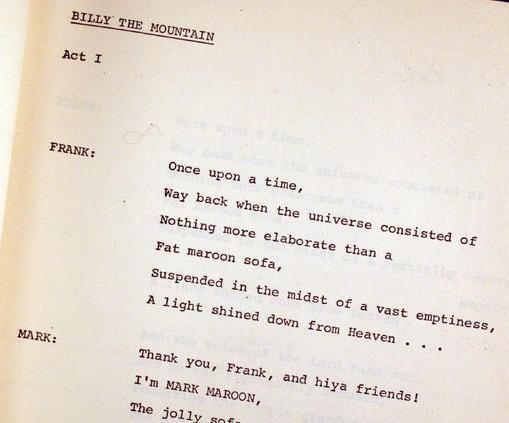 The touring with Flo and Eddie ended abruptly in December 1971 with disasters for the band. At a Montreux gig in November the concert hall took
fire and the touring equipment got destroyed. Worse, Zappa got thrown off a stage in
London the next month, where he had to be taken to a hospital with both legs broken. Zappa
was forced to recuperate at his home in L.A. Indirectly this meant the end of The Mothers of
Invention in this set up.
The touring with Flo and Eddie ended abruptly in December 1971 with disasters for the band. At a Montreux gig in November the concert hall took
fire and the touring equipment got destroyed. Worse, Zappa got thrown off a stage in
London the next month, where he had to be taken to a hospital with both legs broken. Zappa
was forced to recuperate at his home in L.A. Indirectly this meant the end of The Mothers of
Invention in this set up.
The last piece Zappa had been working on for this specific band was a series of songs that
fans gave the name "The sofa suite". In 2011 the ZFT released "Carnegie Hall", including this series of songs,
giving it the name "Divan" after its closing track. Till then it could only be heard in its entirety on the "Fire!" bootleg with the Montreux concert on it. The suite is made up of
"Once upon a time", "Sofa", "Stick it out" and "Divan". The first two songs are present on "You can't do that on stage anymore
Vol. I". "Stick it out" became part of "Joe's garage" from 1979 in a different context, thus released eight years after it was written.
"Divan" can be found on "Playground psychotics". Scattered around in this way the original story can't be
detected anymore in Zappa's own releases.
Parts of the spoken monologues are left out on these CDs, so even when you play these songs as a sequence, the intentions of the
songtexts remain vague. Zappa had the text typed out as a play or script in combination with "Billy the mountain". A copy
got auctioned at www.backstageauctions.com in 2009, from which the sample to the right is taken. The same as with the two previous
plays (the groupie opera and "Billy the mountain"), "The sofa suite" is made up of sections where the lyrics stand central
and parts where the music takes the lead. "Once upon a time" and "Divan" are the textual sections, both using a vamp.
The "Once upon a time" vamp is in C in 12/8 time. In the transcription it's represented by staff 4 in bar 1. At this specific
point the chorus is singing in German over the vamp ("Gib zu mir etwas fürs Bodenbelag unter diesem fätten fliessenden Sofa").
They are singing in three parts, forming a joint harmony progression. Most of the time however the band members are
talking and speechwise singing.
In bar 3 Zappa responds speechwise, translating the previous German sentence ("And of course, ladies and gentlemen, that means
give me a bit of flooring under this fat floating sofa").
The "Divan" vamp is chromatic; it can't be assigned to a specific key. Its lyrics are partially in German and really weird.
The chorus represents the vamp, whereas Zappa is speechwise singing. If I'm
not mistaken, the transcribed section contains part of the following text block:
- Chorus: Laken von gebratenem Wasser.
(German for sheets of fried water.)
- FZ: Sheets of dry wall and ruffing.
- Chorus: Laken von dry wall und roofing.
- FZ: Sheets of large deprived Rhumba.
- Chorus: Laken von riesigen tief-gebadenem Rhumba.
(German for sheets of giant deeply-bathed Rhumba.)
Once upon a time, section (midi file).
Sofa (1971), opening (midi file).
Divan, 0:50 till 1:08 (midi file).
Once upon a time, section (transcription).
Sofa (1971), opening (transcription).
Divan, 0:50 till 1:08 (transcription).
Of the various "sofa" executions the two of its first release on "One size fits all" (1974) are relatively homophonic (except for the example as included
in the One size fits all section).
The "In New York" version contains the counterpoint figure as described in the Weasels ripped my flesh section of this study. This 1971 one allows
much more freedom for the keyboard players. Bars 1-7 are specific for the original 1971 performance; they fit
in well with the comedy character of the shows. Apart from being in 3/4 this one includes the archetype waltz steps
in bars 9-11. Interesting is the figure the keyboards are playing via triplets in bars 24-26, a clear example
of the more independent keyboard part in this version. The keyboard is here shortly playing in 4/4 against the 3/4 of the melody.
"Sofa" begins in C (bars 1-13) and then modulates to G Mixolydian,
simply by changing from C as key note to G as pedal note (these two keys use the same notes).
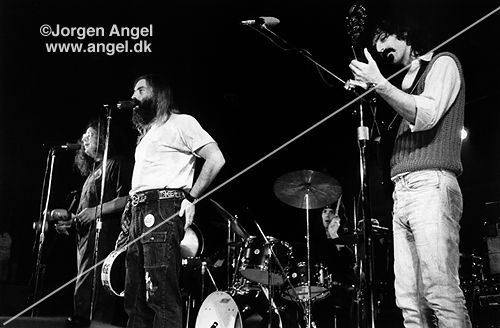 Mark Volman, Howard Kaylan, Aynsley Dunbar and FZ.
Mark Volman, Howard Kaylan, Aynsley Dunbar and FZ.
Photo by Jorgen Angel, used with permission.
Other tracks from Playground psychotics
- "Sleeping in a jar": see the Zappa's teens section.
- "Sharleena": see the Chunga's revenge section.
- "Status back baby": see the Mystery disc-Projects section.
- Mom & dad: the score of this song is included in the Frank Zappa Songbook vol. I, pages 84-89.
- "Intro to Music for low budget orchestra": see the Studio tan section.
- "Billy the mountain": see the Just another band from L.A. section.
"What did you think of Frank Zappa? Whatever happened between you guys and
Frank? Did you remain friends?
Answer:
Howard: "Frank was an icon for a generation, and a true genius...also one of
the greatest guitar players...."
After the incident in London, England, Mark and Howard continued touring
with the members of The Mothers. This was the first Flo & Eddie Band.
Howard: "Yes, we DID see Frank after the Rainbow Theatre accident...It took a
while, but Frank sat in with us in NYC at the Bottom Line one year, and we
sat in with his band in Detroit the year after...."
"Toward the end, we became good friends again, going up to his famous studio
and watching our old concert footage; laughing about the good old days. He
knew that the clock was ticking but he kept chain-smoking, coffee drinking
and eating anchovy pizza...The man was one of the few real geniuses I've
ever had the honour to work with."
In addition to a couple of live onstage guest appearances, in 1987 Mark and
Howard reunited with Frank....
Howard:"Frank's original intention was to get the "Filmore East" band back
together to do one huge world tour...."
"So we got together in L.A. at a rehearsal hall for two days...."
Unfortunately, it was not to be. Apparently there are tapes of the
rehearsals in existence somewhere.
When asked which of his bands were Frank's favourites, Gail Zappa was quoted
in an interview as saying he liked all of them, but mentioned Mark, Howard
and Aynsley Dunbar as particular favourite members for their talent and
senses of humour."
